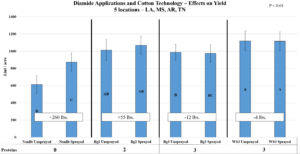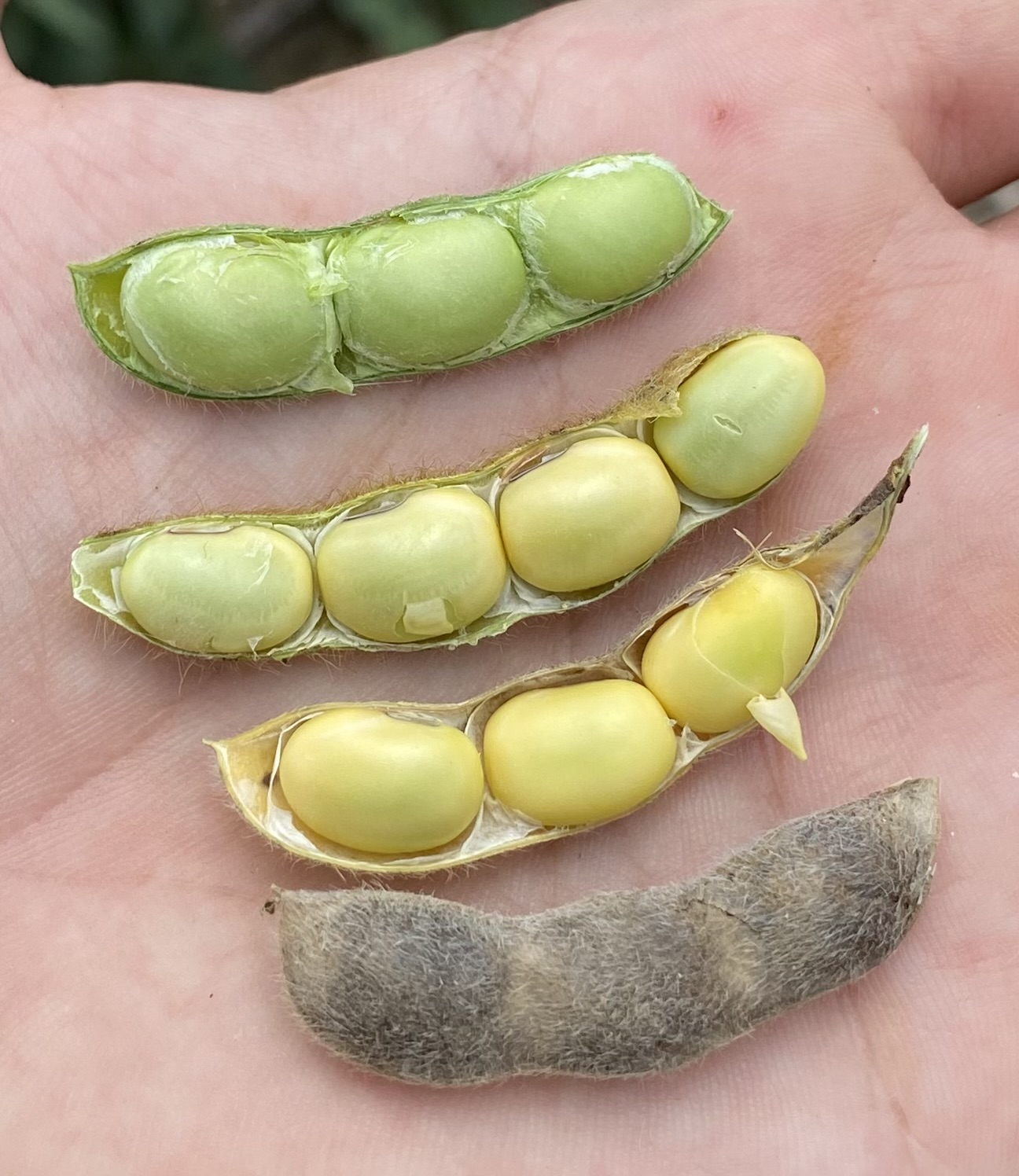| Location | CEW | TBW |
| Hardeman (Bolivar) | 4 | 0 |
| Fayette (Whiteville) | 1 | 0 |
| Fayette (Somerville) | 0 | 0 |
| Shelby (Millington) | 5 | 0 |
| Tipton (Covington) | 2 | 0 |
| Tipton (North) | 1 | 0 |
| Lauderdale (Golddust) | 2 | 0 |
| Haywood(West) | 0 | 0 |
| Haywood (Brownsville) | 0 | 0 |
| Madison (WTREC) | 125 | 5 |
| Madison (North) | 1 | 0 |
| Crockett (Alamo) | 0 | 0 |
| Crockett (Friendship) | 0 | 0 |
| Dyer (King Rd) | 7 | 0 |
| Dyer (Dyersburg) | 8 | 2 |
| Lake (Ridgely) | 7 | 0 |
| Gibson (Trenton) | 0 | 0 |
| Gibson (Milan Rec) | 0 | 0 |
| Carroll (Coleman Farm) | 7 | 0 |
Category Archives: Cotton
2024 Soybean Desiccation
Bollworm Egg Lay Increasing In Cotton
Bollworm egg lay across West TN is rapidly increasing. Our trap catches across the survey area are steadily increasing and I’ve started receiving several calls about large numbers of eggs . Fortunately, the vast majority of our cotton is Widestrike 3 (WS3) or Bollgard 3 (BG3). To date, I’ve had no reports of slippage through any three gene cotton in Tennessee. Going forward, our threshold for foliar applications targeting bollworms occurs when a combination of square and boll sampling shows 6 percent or more injury (e.g., 3 percent square injury and 3 percent boll injury, 4 percent square injury and 2 percent boll injury, etc.) and/or 4 or more larvae are present per 100 plants. Treatments based on egg lay is not recommended in 3 gene cottons. My colleague at Mississippi State, Dr. Tyler Towles, summarized our regional data (Fig. 1) demonstrating no economic benefit to making a diamide application to 3 gene cottons. Unless you’re at threshold, save the money on the diamide spray in 3 gene cotton.

One final note, as we are nearing the end of the 2024 growing season below are insect termination timings based on DD60s.
- Tarnished Plant Bugs: NAWF 5 + 300 DD60s
- Bollworms: NAWF 5 + 350-400 DD60s
- Spider Mites: NAWF 5 + 350 DD60s
- Stinkbugs: NAWF 5 + 400-450 DD60s
- Fall Armyworms: NAWF 5 + 400-450 DD60s
Bollworm/Budworm Trap Catches 8/7
| Location | CEW | TBW |
| Hardeman (Bolivar) | 4 | 0 |
| Fayette (Whiteville) | 0 | 0 |
| Fayette (Somerville) | 2 | 0 |
| Shelby (Millington) | 16 | 2 |
| Tipton (Covington) | 3 | 0 |
| Tipton (North) | 2 | 0 |
| Lauderdale (Golddust) | 6 | 0 |
| Haywood(West) | 0 | 0 |
| Haywood (Brownsville) | 0 | 0 |
| Madison (WTREC) | 126 | 1 |
| Madison (North) | 0 | 0 |
| Crockett (Alamo) | 0 | 0 |
| Crockett (Friendship) | 1 | 0 |
| Dyer (King Rd) | 13 | 1 |
| Dyer (Dyersburg) | 10 | 11 |
| Lake (Ridgely) | 20 | 1 |
| Gibson (Trenton) | 13 | 0 |
| Gibson (Milan Rec) | 0 | 0 |
| Carroll (Coleman Farm) | 3 | 0 |
Bollworm/Budworm Trap Catches 8/1
| Location | CEW | TBW |
| Hardeman (Bolivar) | 3 | 0 |
| Fayette (Whiteville) | 1 | 0 |
| Fayette (Somerville) | 2 | 0 |
| Shelby (Millington) | 12 | 1 |
| Tipton (Covington) | 1 | 0 |
| Tipton (North) | 0 | 0 |
| Lauderdale (Golddust) | 4 | 0 |
| Haywood(West) | 5 | 0 |
| Haywood (Brownsville) | 0 | 0 |
| Madison (WTREC) | 41 | 0 |
| Madison (North) | 0 | 0 |
| Crockett (Alamo) | 0 | 0 |
| Crockett (Friendship) | 0 | 1 |
| Dyer (King Rd) | 9 | 1 |
| Dyer (Dyersburg) | 8 | 8 |
| Lake (Ridgely) | 2 | 1 |
| Gibson (Trenton) | 20 | 0 |
| Gibson (Milan Rec) | 0 | 0 |
| Carroll (Coleman Farm) | 1 | 1 |
Bollworm/Budworm Catches 7/26
| Location | CEW | TBW |
| Hardeman (Bolivar) | 2 | 0 |
| Fayette (Whiteville) | 2 | 0 |
| Fayette (Somerville) | 0 | 0 |
| Shelby (Millington) | 12 | 0 |
| Tipton (Covington) | 1 | 0 |
| Tipton (North) | 0 | 0 |
| Lauderdale (Golddust) | 4 | 0 |
| Haywood(West) | 0 | 0 |
| Haywood (Brownsville) | 0 | 0 |
| Madison (WTREC) | 19 | 0 |
| Madison (North) | 0 | 0 |
| Crockett (Alamo) | 0 | 0 |
| Crockett (Friendship) | 0 | 0 |
| Dyer (King Rd) | 0 | 0 |
| Dyer (Dyersburg) | 5 | 0 |
| Lake (Ridgely) | 10 | 0 |
| Gibson (Trenton) | 2 | 0 |
| Gibson (Milan Rec) | 0 | 0 |
| Carroll (Coleman Farm) | 1 | 0 |
Budworm/Bollworm Catches 7/18
| Location | CEW | TBW |
| Hardeman (Bolivar) | 0 | 0 |
| Fayette (Whiteville) | 0 | 0 |
| Fayette (Somerville) | 1 | 0 |
| Shelby (Millington) | 1 | 0 |
| Tipton (Covington) | 1 | 0 |
| Tipton (North) | 0 | 0 |
| Lauderdale (Golddust) | 16 | 0 |
| Haywood(West) | 12 | 0 |
| Haywood (Brownsville) | 0 | 0 |
| Madison (WTREC) | 107 | 6 |
| Madison (North) | 2 | 0 |
| Crockett (Alamo) | 0 | 0 |
| Crockett (Friendship) | 1 | 0 |
| Dyer (King Rd) | 7 | 0 |
| Dyer (Dyersburg) | 5 | 0 |
| Lake (Ridgely) | 1 | 0 |
| Gibson (Trenton) | 4 | 0 |
| Gibson (Milan Rec) | 0 | 0 |
| Carroll (Coleman Farm) | 2 | 3 |
Considerations for PGRs and fungicides in an abnormally cool July
A drastic change in weather pattern has brought cooler temperatures and rainfall into the forecast for the remaining days of July. Recent calls have questioned how we might need to change our approach to plant growth regulation and fungicides, given this abnormal forecast. In this blog, I highlight a couple of things to consider as we move into next week. Continue reading


